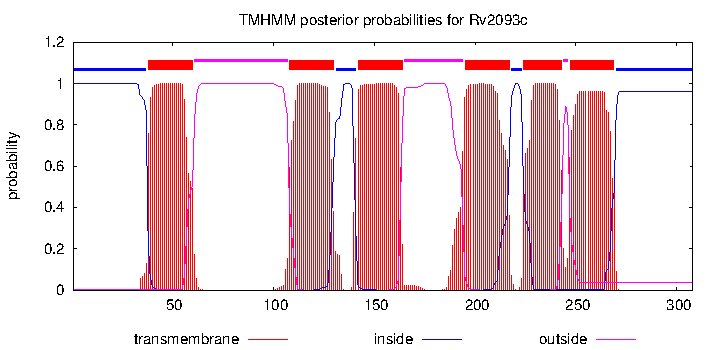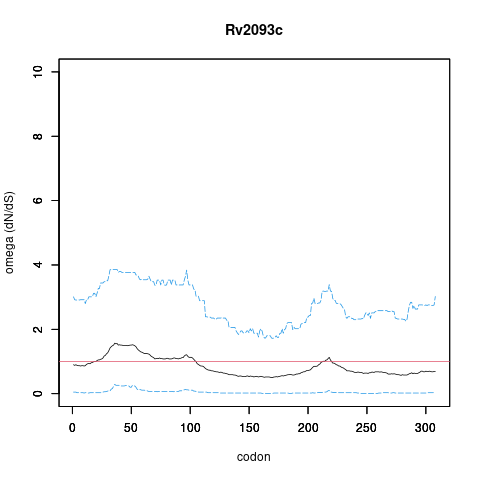Rv2093c (tatC)
Current annotations:
TBCAP: (community-based annotations - see table at bottom of page )
TBDB: twin arginine-targeting protein translocase TatC
REFSEQ: Sec-independent protein translocase transmembrane protein tatC
PATRIC: Twin-arginine translocation protein TatC
TUBERCULIST: Sec-independent protein translocase transmembrane protein TatC
NCBI: Sec-independent protein translocase transmembrane protein TatC
updated information (H37Rv4):
gene name: tatC
function:
reference:
Type: Not Target
Start: 2352103
End: 2353029
Operon:
Trans-membrane region:
Role: II.C.5 - Other membrane proteins
GO terms:
GO:0065002 - intracellular protein transmembrane transport (Uniprot)
GO:0043953 - protein transport by the Tat complex (Uniprot)
GO:0040007 - growth (Uniprot)
GO:0033281 - TAT protein transport complex (Uniprot)
GO:0016021 - integral component of membrane (Uniprot)
GO:0016020 - membrane (Uniprot)
GO:0015031 - protein transport (Uniprot)
GO:0009977 - proton motive force dependent protein transmembrane transporter activity (Uniprot)
GO:0005886 - plasma membrane (Uniprot)
GO:0005829 - cytosol (Uniprot)
Reaction(s) (based on iSM810 metabolic model):
Gene Expression Profile Gene Modules Orthologs among selected mycobacteria Protein structure:
Search for Homologs in PDB Top 10 Homologs in PDB (as of Nov 2020): (none with >35% aa id)
Links to additional information on tatC:
Amino Acid Sequence
VRAAGLLKRLNPRNRRSRVNPDATMSLVDHLTELRTRLLISLAAILVTTIFGFVWYSHSIFGLDSLGEWLRHPYCALPQSARADISADGECRLLATAPFD
QFMLRLKVGMAAGIVLACPVWFYQLWAFITPGLYQRERRFAVAFVIPAAVLFVAGAVLAYLVLSKALGFLLTVGSDVQVTALSGDRYFGFLLNLLVVFGV
SFEFPLLIVMLNLAGLLTYERLKSWRRGLIFAMFVFAAIFTPGSDPFSMTALGAALTVLLELAIQIARVHDKRKAKREAAIPDDEASVIDPPSPVPAPSV
IGSHDDVT
(
Nucleotide sequence available on
KEGG )
Additional Information
Analysis of Positive Selection in Clinical Isolates
*new*
Analysis of dN/dS (omega) in two collections of Mtb clinical isolates using GenomegaMap (Window model) (see description of methods )
Moldova: 2,057 clinical isolates
global set: 5,195 clinical isolates from 15 other countries
In the omega plots, the black line shows the mean estimate of omega (dN/dS) at each codon, and the blue lines are the bounds for the 95% credible interval (95%CI, from MCMC sampling).
A gene is under significant positive selection if the lower-bound of the 95%CI of omega (lower blue line) exceeds 1.0 at any codon.
Moldova (2,057) global set (5,195)
under significant positive selection? NO NO
omega peak height (95%CI lower bound) 1.57 (0.29) 1.58 (0.64)
codons under selection
omega plots
genetic variants* link link
statistics at each codon link link
* example format for variants: "D27 (GAC): D27H (CAC,11)" means "Asp27 (native codon GAC) mutated to His (codon CAC) in 11 isolates"
MtbTnDB - interactive tool for exploring a database of published TnSeq datasets for Mtb
TnSeqCorr
Rv2093c/tatC,
gene len: 926 bp, num TA sites: 13
condition dataset call medium method notes
in-vitro DeJesus 2017 mBio growth defect 7H9 HMM fully saturated, 14 TnSeq libraries combined
in-vitro Sassetti 2003 Mol Micro essential 7H9 TRASH essential if hybridization ratio<0.2
in-vivo (mice) Sassetti 2003 PNAS no data BL6 mice TRASH essential if hybridization ratio<0.4, min over 4 timepoints (1-8 weeks)
in-vitro (glycerol) Griffin 2011 PPath essential M9 minimal+glycerol Gumbel 2 replicates; Padj<0.05
in-vitro (cholesterol) Griffin 2011 PPath essential M9 minimal+cholesterol Gumbel 3 replicates; Padj<0.05
differentially essential in cholesterol Griffin 2011 PPath NO (LFC=0.0) cholesterol vs glycerol resampling-SR YES if Padj<0.05, else not significant; LFC<0 means less insertions/more essential in cholesterol
in-vitro Smith 2022 eLife essential 7H9 HMM 6 replicates (raw data in Subramaniam 2017, PMID 31752678)
in-vivo (mice) Smith 2022 eLife essential BL6 mice HMM 6 replicates (raw data in Subramaniam 2017, PMID 31752678)
differentially essential in mice Smith 2022 eLife NO (LFC=0.026) in-vivo vs in-vitro ZINB YES if Padj<0.05, else not significant; LFC<0 means less insertions/more essential in mice
in-vitro (minimal) Minato 2019 mSys essential minimal medium HMM
in-vitro (YM rich medium) Minato 2019 mSys essential YM rich medium HMM 7H9 supplemented with ~20 metabolites (amino acids, cofactors)
differentially essential in YM rich medium Minato 2019 mSys NO (LFC=-1.48) YM rich vs minimal medium resampling
TnSeq Data No data currently available.
No TnSeq data currently available for this Target.
RNASeq Data No data currently available.
No RNA-Seq data currently available for this Target.
Metabolomic Profiles No data currently available.
No Metabolomic data currently available for this Target.
Proteomic Data No data currently available.
No Proteomic data currently available for this Target.
Regulatory Relationships from Systems Biology
BioCyc
Gene interactions based on ChIPSeq and Transcription Factor Over-Expression (TFOE) (Systems Biology )
NOTE:
Green edges represent the connected genes being classified as differentially essential as a result of the middle gene being knocked out. These interactions are inferred based on RNASeq.
Interactions based on ChIPSeq data
RNA processing and modification
Energy production and conversion
Chromatin structure and dynamics
Amino acid transport and metabolism
Cell cycle control, cell division, chromosome partitioning
Carbohydrate transport and metabolism
Nucleotide transport and metabolism
Lipid transport and metabolism
Coenzyme transport and metabolism
Translation, ribosomal structure and biogenesis
Cell wall/membrane/envelope biogenesis
Replication, recombination and repair
Posttranslational modification, protein turnover, chaperones
Secondary metabolites biosynthesis, transport and catabolism
Inorganic ion transport and metabolism
General function prediction only
Intracellular trafficking, secretion, and vesicular transport
Signal transduction mechanisms
Differentially expressed as result of RNASeq in glycerol environment (Only top 20 genes shown sorted by log fold change with p_adj 0.05).
Conditionally essential as result of TNSeq (Only top 20 genes shown sorted by log fold change with p_adj 0.05).
Binds To:
No bindings to other targets were found.
Bound By:
No bindings from other targets were found.
Binds To:
No bindings to other targets were found.
Bound By:
Upregulates:
Does not upregulate other genes.
Upregulated by:
Not upregulated by other genes.
Downregulates:
Does not downregulate other genes.
Downregulated by:
Not downregulated by other genes.
Property Value Creator Evidence PMID Comment
Citation The twin-arginine translocation pathway of Mycobacterium smegmatis is functional and required for the export of mycobacterial beta-lactamases. JA. McDonough, KE. Hacker et al. J. Bacteriol. 2005 ashwinigbhat IDA 16267291 Spectrophotometric Analysis
Interaction PhysicalInteraction Rv2068c ashwinigbhat IDA Spectrophotometric AnalysisJA. McDonough, KE. Hacker et al. The twin-arginine translocation pathway of Mycobacterium smegmatis is functional and required for the export of mycobacterial beta-lactamases. J. Bacteriol. 2005
Citation Characterization of the twin-arginine translocase secretion system of Mycobacterium smegmatis. JE. Posey, TM. Shinnick et al. J. Bacteriol. 2006 priti.priety IDA 16452415 Spectrophotometric Analysis
Interaction PhysicalInteraction Rv2068c priti.priety IDA Spectrophotometric AnalysisJE. Posey, TM. Shinnick et al. Characterization of the twin-arginine translocase secretion system of Mycobacterium smegmatis. J. Bacteriol. 2006
Citation The twin-arginine translocation pathway of Mycobacterium smegmatis is functional and required for the export of mycobacterial beta-lactamases. JA. McDonough, KE. Hacker et al. J. Bacteriol. 2005 priti.priety IDA 16267291 Spectrophotometric Analysis
Interaction PhysicalInteraction Rv2068c priti.priety IDA Spectrophotometric AnalysisJA. McDonough, KE. Hacker et al. The twin-arginine translocation pathway of Mycobacterium smegmatis is functional and required for the export of mycobacterial beta-lactamases. J. Bacteriol. 2005
Citation Characterization of the twin-arginine translocase secretion system of Mycobacterium smegmatis. JE. Posey, TM. Shinnick et al. J. Bacteriol. 2006 ashwinigbhat IDA 16452415 Spectrophotometric Analysis
Interaction PhysicalInteraction Rv2068c ashwinigbhat IDA Spectrophotometric AnalysisJE. Posey, TM. Shinnick et al. Characterization of the twin-arginine translocase secretion system of Mycobacterium smegmatis. J. Bacteriol. 2006
Interaction Operon Rv1224 gaat3s NAS Gene Neighbourhood(Functional Linkage)JA. McDonough, KE. Hacker et al. The twin-arginine translocation pathway of Mycobacterium smegmatis is functional and required for the export of mycobacterial beta-lactamases. J. Bacteriol. 2005
Interaction Operon Rv1224 gaat3s NAS Gene Neighbourhood(Functional Linkage)JE. Posey, TM. Shinnick et al. Characterization of the twin-arginine translocase secretion system of Mycobacterium smegmatis. J. Bacteriol. 2006
Interaction Operon Rv1224 gaat3s NAS Gene Neighbourhood(Functional Linkage)authors,BC. Berks,F. Sargent,T. Palmer The Tat protein export pathway. Mol. Microbiol. 2000
Citation The twin-arginine translocation pathway of Mycobacterium smegmatis is functional and required for the export of mycobacterial beta-lactamases. JA. McDonough, KE. Hacker et al. J. Bacteriol. 2005 jlew 16267291 MS deletion mutant. We describe phenotypic analyses of tatA and tatC deletion mutants of M. smegmatis, which demonstrated that tatA and tatC encode components of a functional Tat system.
Citation Inactivation of Rv2525c, a substrate of the twin arginine translocation (Tat) system of Mycobacterium tuberculosis, increases beta-lactam susceptibility and virulence. B. Saint-Joanis, C. Demangel et al. J. Bacteriol. 2006 jlew 16952959 essential in Mtb. Saint-Joanis B, Demangel C, Jackson M, Brodin P, Marsollier L, Boshoff H, Cole ST.


